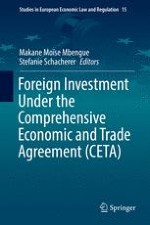2019 | OriginalPaper | Chapter
A Latin American View on the CETA Investment Chapter
Author : Ely Caetano Xavier Junior
Published in: Foreign Investment Under the Comprehensive Economic and Trade Agreement (CETA)
Publisher: Springer International Publishing
Activate our intelligent search to find suitable subject content or patents.
Select sections of text to find matching patents with Artificial Intelligence. powered by
Select sections of text to find additional relevant content using AI-assisted search. powered by
